As consumers, we pay taxes on many things, and while no one enjoys paying taxes, we are required to do so. We pay taxes on our income at the local, state, and federal levels. We also pay taxes on goods and services that we purchase.
The field of economics considers how this activity changes the overall market outcome. How will the quantity purchased or supplied be affected? How will the price of the good be affected?
Now, in this lesson, we will be focusing on an excise tax, which is a tax paid by the supplier or producer of a good. It can be imposed by any government strata--federal, state, or local level.
Here is a graph for a per unit tax on sellers.
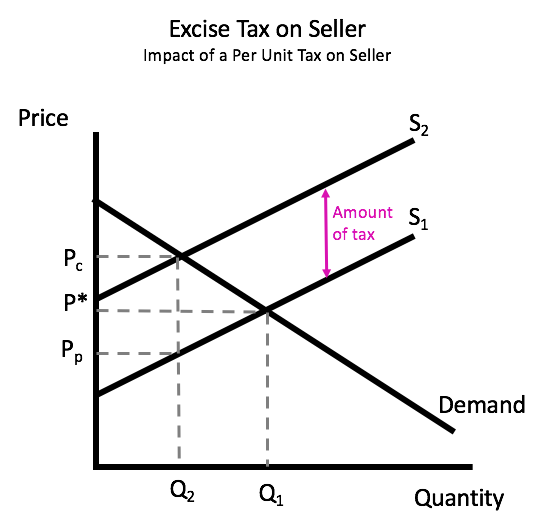
When there is a tax, the supply curve shifts to the left, in the amount represented by the tax. This increases the price that consumers pay, which is indicated by Pc. If P* was the initial equilibrium price, now consumers are paying the new market price, Pc.
Now, the quantity labeled as Q2 shows that because of the increase in price, consumers are going to buy less. The price that producers are receiving is not Pc, but rather Pp, because they have to pay that amount of the tax.
In other words, if consumers are paying Pc, producers are only receiving the price labeled as Pp.
Now, many people would assume that if a tax is 10%, for example, then it would simply increase the price of an item by 10%. Generally, though, that is not the case. If sellers were able to pass the entire amount of the tax on to consumers, it would be represented in a graph like this, because producers would supply exactly the same quantity as before.
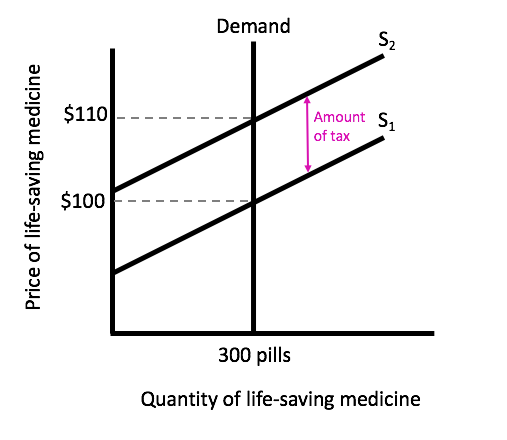
However, with most items, demand is not perfectly inelastic; consumers do purchase less as the price rises. Therefore, the graph would show a shift to the left of the supply curve when factoring in a tax.
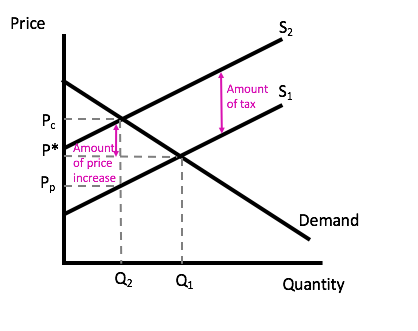
Notice that the change in price from P* to Pc is not the same as the amount of the tax when demand is not perfectly inelastic, as is typically the case. The change in price is less.
In the next section, we will walk through the amount of the actual price increase, which is the impact on consumers, given a certain amount of tax.
Now, let's turn our attention to how a tax impacts the consumer and the producer, and one way to do this is to look at consumer and producer surplus.
You may recall that consumer surplus is the difference between what consumers are willing to pay for things and what they have to pay, represented by the green triangle below. This area reflects all of the people who are receiving this item for less than they were actually willing to pay for it.
Producer surplus is the blue triangle, which is all of the producers who were willing to supply the item for less than they were able to receive for it.

Now, if that was the initial consumer and producer surplus, the graph below represents the new consumer and producer surplus if the supply were to shift to the left by the amount of the tax.
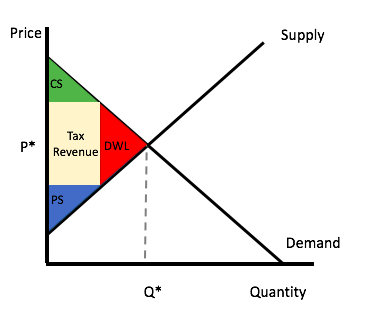
As you can see, both consumer surplus and producer surplus shrink as a result of the tax, while tax revenue is generated. This tax revenue is the quantity being purchased times the amount of the tax.
This tax revenue used to be part of consumer and producer surplus, but now it is going to the government at some level.
Now, there will also be a deadweight loss, due to the lower quantity being purchased from the tax. It represents part of the consumer and producer surplus that is no longer being realized by consumers or producers.
So, what we will be able to see is whether consumers or producers are impacted more.
This is another way to look at the effect on consumers and producers, which can be helpful. The blue and green parallelograms combined represent tax revenue. The green area represents consumers paying the tax, while the blue area is the producer's share of the tax. The red area is a deadweight loss.
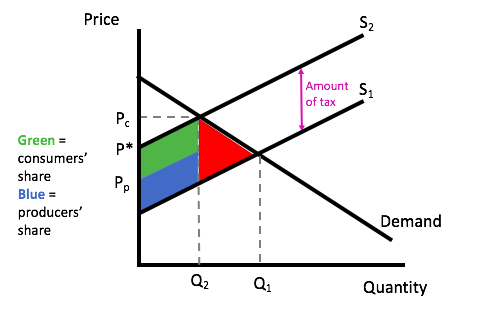
If the green area is larger than the blue area, consumers pay the majority of the tax, and vice versa. If the blue area is larger than the green area, the producer's share of tax is greater.
So, how do we determine who pays the greater share of tax, or the tax burden? A tax burden defined is the proportion of tax borne between a supplier and consumer of a good where either party may be the original tax recipient.
Who ends up paying the tax--the consumer, the producer, or both?
Well, it depends on the good or service, and it ultimately comes down to elasticity of demand or supply. Elasticity is defined as the change in quantity demanded or supplied resulting from a change in the price of that good or service, referring to own-price elasticity.
Consider the graph below. When demand is elastic, producers cannot raise the price much without losing a lot in sales. If P1 is the initial price and the orange arrow is the amount of the tax, producers can only raise the price a small amount, up to P2, to ensure that consumers are not overly impacted.
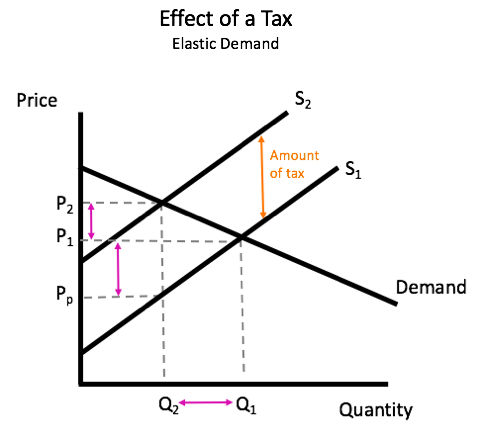
In this case, producers bear most of the burden, indicated by the larger pink arrow. Not only can they not increase the price, but there is also a significant decrease in the quantity purchased.
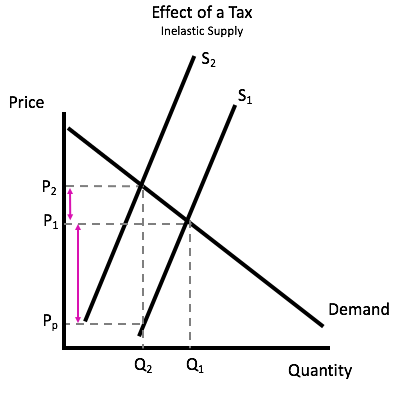
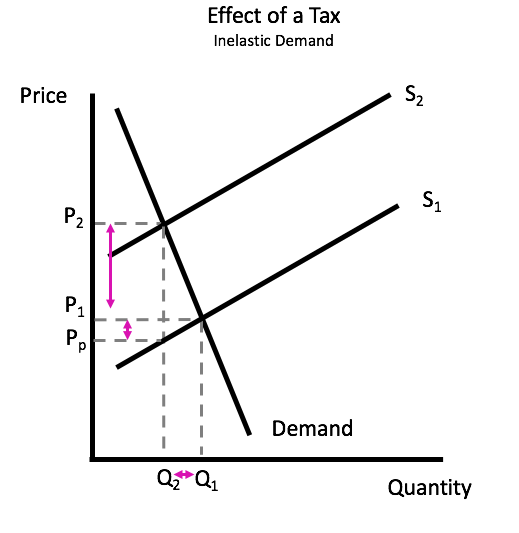
In this case, consumers have a harder time finding substitutes, so producers can actually raise the price to cover most of the tax without risking the loss of many sales. Consumers bear most of the tax burden in the form of higher prices, shown by the larger arrow. The producers' burden is minimal.

You may recall that a subsidy is different from a tax. A subsidy is a sum that is paid, typically by a government entity, to either suppliers or consumers to assist in the production or purchase of a good or service. It is typically used to encourage the production of a good or service.
Subsidies shift the supply curve to the right. Consumers pay a lower price, as shown below at Pc, while producers receive a higher price at Pp.
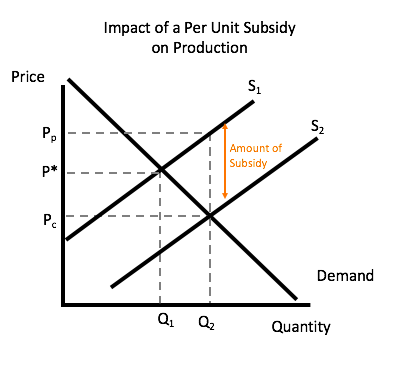
Now, in the case of subsidy, it is not really about who pays the incidence; it is about who collects it.
As you can see in the graphs below, with elastic demand, producers will receive more of it, and with inelastic demand, consumers will receive more of it.
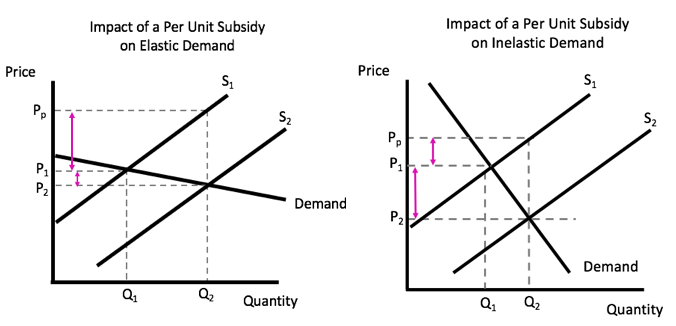
Source: This work is adapted from Sophia author Kate Eskra.